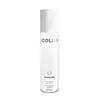What's inside
What's inside
 Key Ingredients
Key Ingredients

No key ingredients
 Benefits
Benefits

 Concerns
Concerns

 Ingredients Side-by-side
Ingredients Side-by-side

Avena Sativa Seed Water 30%
SolventWater
Skin ConditioningSodium Cocoyl Isethionate
CleansingCoco-Glucoside
CleansingGlycerin
HumectantGlyceryl Stearate
EmollientButylene Glycol
Humectant1,2-Hexanediol
Skin ConditioningCoconut Acid
CleansingSodium Methyl Cocoyl Taurate
CleansingArachidyl Alcohol
EmollientHydroxypropyl Starch Phosphate
Coco-Betaine
CleansingAvena Sativa Kernel Flour
AbrasiveBehenyl Alcohol
EmollientSodium Isethionate
CleansingSodium Chloride
MaskingArachidyl Glucoside
EmulsifyingArginine
MaskingCaprylyl Glycol
EmollientCapryloyl Salicylic Acid
ExfoliatingAniba Rosodora Wood Oil
AstringentPentylene Glycol
Skin ConditioningMalt Extract
Skin ProtectingGlucose
HumectantPueraria Lobata Root Extract
HumectantPinus Palustris Leaf Extract
TonicUlmus Davidiana Root Extract
Skin ConditioningOenothera Biennis Flower Extract
AstringentCitric Acid
BufferingLinalool
PerfumingEthylhexylglycerin
Skin ConditioningAvena Sativa Seed Water 30%, Water, Sodium Cocoyl Isethionate, Coco-Glucoside, Glycerin, Glyceryl Stearate, Butylene Glycol, 1,2-Hexanediol, Coconut Acid, Sodium Methyl Cocoyl Taurate, Arachidyl Alcohol, Hydroxypropyl Starch Phosphate, Coco-Betaine, Avena Sativa Kernel Flour, Behenyl Alcohol, Sodium Isethionate, Sodium Chloride, Arachidyl Glucoside, Arginine, Caprylyl Glycol, Capryloyl Salicylic Acid, Aniba Rosodora Wood Oil, Pentylene Glycol, Malt Extract, Glucose, Pueraria Lobata Root Extract, Pinus Palustris Leaf Extract, Ulmus Davidiana Root Extract, Oenothera Biennis Flower Extract, Citric Acid, Linalool, Ethylhexylglycerin
Water
Skin ConditioningCetearyl Isononanoate
EmollientOctyldodecanol
EmollientButylene Glycol
HumectantC14-22 Alcohols
Emulsion StabilisingPropanediol
SolventCaprylhydroxamic Acid
Argania Spinosa Kernel Oil
EmollientAllantoin
Skin ConditioningAloe Barbadensis Leaf Juice
Skin ConditioningPanthenol
Skin ConditioningEscin
TonicRuscus Aculeatus Root Extract
AstringentAmmonium Glycyrrhizate
MaskingCentella Asiatica Leaf Extract
Skin ConditioningHydrolyzed Yeast Protein
Skin ConditioningCalendula Officinalis Flower Extract
MaskingPotassium Sorbate
PreservativeSodium Benzoate
Masking1,2-Hexanediol
Skin ConditioningCetyl Alcohol
EmollientGlyceryl Stearate Se
EmulsifyingPEG-100 Stearate
C12-20 Alkyl Glucoside
EmulsifyingAcrylamide/Ammonium Acrylate Copolymer
Xanthan Gum
EmulsifyingStearyl Alcohol
EmollientDisodium EDTA
Polyisobutene
Polysorbate 20
EmulsifyingTriethanolamine
BufferingSorbitan Isostearate
EmulsifyingGlycerin
HumectantSodium Citrate
BufferingCitric Acid
BufferingWater, Cetearyl Isononanoate, Octyldodecanol, Butylene Glycol, C14-22 Alcohols, Propanediol, Caprylhydroxamic Acid, Argania Spinosa Kernel Oil, Allantoin, Aloe Barbadensis Leaf Juice, Panthenol, Escin, Ruscus Aculeatus Root Extract, Ammonium Glycyrrhizate, Centella Asiatica Leaf Extract, Hydrolyzed Yeast Protein, Calendula Officinalis Flower Extract, Potassium Sorbate, Sodium Benzoate, 1,2-Hexanediol, Cetyl Alcohol, Glyceryl Stearate Se, PEG-100 Stearate, C12-20 Alkyl Glucoside, Acrylamide/Ammonium Acrylate Copolymer, Xanthan Gum, Stearyl Alcohol, Disodium EDTA, Polyisobutene, Polysorbate 20, Triethanolamine, Sorbitan Isostearate, Glycerin, Sodium Citrate, Citric Acid
Ingredients Explained
These ingredients are found in both products.
Ingredients higher up in an ingredient list are typically present in a larger amount.
1,2-Hexanediol is a synthetic liquid and another multi-functional powerhouse.
It is a:
- Humectant, drawing moisture into the skin
- Emollient, helping to soften skin
- Solvent, dispersing and stabilizing formulas
- Preservative booster, enhancing the antimicrobial activity of other preservatives
Butylene Glycol (or BG) is used within cosmetic products for a few different reasons:
Overall, Butylene Glycol is a safe and well-rounded ingredient that works well with other ingredients.
Though this ingredient works well with most skin types, some people with sensitive skin may experience a reaction such as allergic rashes, closed comedones, or itchiness.
Learn more about Butylene GlycolCitric Acid is an alpha hydroxy acid (AHA) naturally found in citrus fruits like oranges, lemons, and limes.
Like other AHAs, citric acid can exfoliate skin by breaking down the bonds that hold dead skin cells together. This helps reveal smoother and brighter skin underneath.
However, this exfoliating effect only happens at high concentrations (20%) which can be hard to find in cosmetic products.
Due to this, citric acid is usually included in small amounts as a pH adjuster. This helps keep products slightly more acidic and compatible with skin's natural pH.
In skincare formulas, citric acid can:
While it can provide some skin benefits, research shows lactic acid and glycolic acid are generally more effective and less irritating exfoliants.
Most citric acid used in skincare today is made by fermenting sugars (usually from molasses). This synthetic version is identical to the natural citrus form but easier to stabilize and use in formulations.
Read more about some other popular AHA's here:
Learn more about Citric AcidGlycerin is already naturally found in your skin. It helps moisturize and protect your skin.
A study from 2016 found glycerin to be more effective as a humectant than AHAs and hyaluronic acid.
As a humectant, it helps the skin stay hydrated by pulling moisture to your skin. The low molecular weight of glycerin allows it to pull moisture into the deeper layers of your skin.
Hydrated skin improves your skin barrier; Your skin barrier helps protect against irritants and bacteria.
Glycerin has also been found to have antimicrobial and antiviral properties. Due to these properties, glycerin is often used in wound and burn treatments.
In cosmetics, glycerin is usually derived from plants such as soybean or palm. However, it can also be sourced from animals, such as tallow or animal fat.
This ingredient is organic, colorless, odorless, and non-toxic.
Glycerin is the name for this ingredient in American English. British English uses Glycerol/Glycerine.
Learn more about GlycerinWater. It's the most common cosmetic ingredient of all. You'll usually see it at the top of ingredient lists, meaning that it makes up the largest part of the product.
So why is it so popular? Water most often acts as a solvent - this means that it helps dissolve other ingredients into the formulation.
You'll also recognize water as that liquid we all need to stay alive. If you see this, drink a glass of water. Stay hydrated!
Learn more about Water